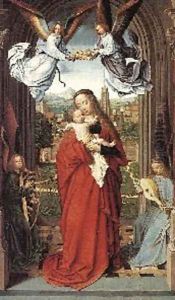David Gerard Paintings
David Gerard, also known as Gerard David, was an Early Netherlandish painter born around 1460 in Oudewater, near Utrecht in the Netherlands. Not much is known about his early life or training, but it is believed that he may have been a student of Albert van Ouwater, another Early Netherlandish painter who was active in Haarlem. By the 1480s, Gerard had moved to Bruges, which was then one of the most important centers for art and commerce in Europe. He became a master in the Guild of St. Luke there in 1484, which indicates that by this time he was an independent artist.
Gerard's work is characterized by its detailed narrative and devotional scenes, often featuring religious themes. He was influenced by the work of Jan van Eyck and Rogier van der Weyden, and his paintings display a similar attention to detail and use of rich, vibrant colors. Gerard was particularly skilled in the use of oil paint, a relatively new medium at the time, which allowed for a range of subtle color effects and intricate detailing.
Throughout his career, Gerard accepted a wide range of commissions, from altarpieces and religious panels to portraits. One of his most famous works is the 'Virgin and Child with Four Angels', which showcases his ability to create serene and intimate religious scenes. His 'Judgment of Cambyses' is another significant work, notable for its vivid depiction of the gruesome punishment of a corrupt judge.
Gerard's influence was significant in the spread of the Netherlandish painting style, and he is known to have had several students and followers. His works were highly sought after and he enjoyed a successful career. Despite his influence, Gerard's name was somewhat overshadowed by his contemporaries, and it was only later that art historians began to fully recognize the importance of his contribution to the Northern Renaissance.
David Gerard died in Bruges in 1523. His legacy lives on through his contributions to the development of Netherlandish painting, and his works continue to be studied and admired for their beauty and historical importance.
